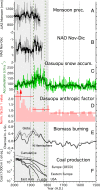Early atmospheric contamination on the top of the Himalayas since the onset of the European Industrial Revolution
- PMID: 32041888
- PMCID: PMC7049134
- DOI: 10.1073/pnas.1910485117
Early atmospheric contamination on the top of the Himalayas since the onset of the European Industrial Revolution
Abstract
Because few ice core records from the Himalayas exist, understanding of the onset and timing of the human impact on the atmosphere of the "roof of the world" remains poorly constrained. We report a continuous 500-y trace metal ice core record from the Dasuopu glacier (7,200 m, central Himalayas), the highest drilling site on Earth. We show that an early contamination from toxic trace metals, particularly Cd, Cr, Mo, Ni, Sb, and Zn, emerged at high elevation in the Himalayas at the onset of the European Industrial Revolution (∼1780 AD). This was amplified by the intensification of the snow accumulation (+50% at Dasuopu) likely linked to the meridional displacement of the winter westerlies from 1810 until 1880 AD. During this period, the flux and crustal enrichment factors of the toxic trace metals were augmented by factors of 2 to 4 and 2 to 6, respectively. We suggest this contamination was the consequence of the long-range transport and wet deposition of fly ash from the combustion of coal (likely from Western Europe where it was almost entirely produced and used during the 19th century) with a possible contribution from the synchronous increase in biomass burning emissions from deforestation in the Northern Hemisphere. The snow accumulation decreased and dry winters were reestablished in Dasuopu after 1880 AD when lower than expected toxic metal levels were recorded. This indicates that contamination on the top of the Himalayas depended primarily on multidecadal changes in atmospheric circulation and secondarily on variations in emission sources during the last 200 y.
Keywords: North Atlantic Oscillation; ice cores; monsoon; paleoenvironment; trace metals.
Conflict of interest statement
The authors declare no competing interest.
Figures




Similar articles
-
Uncovering sources, distribution, and seasonal patterns of trace element deposition: the elemental puzzle of the western Himalayas.Environ Sci Pollut Res Int. 2024 May;31(25):37196-37214. doi: 10.1007/s11356-024-33601-6. Epub 2024 May 20. Environ Sci Pollut Res Int. 2024. PMID: 38764085
-
Historical record of European emissions of heavy metals to the atmosphere since the 1650s from alpine snow/ice cores drilled near Monte Rosa.Environ Sci Technol. 2004 Aug 1;38(15):4085-90. doi: 10.1021/es049759r. Environ Sci Technol. 2004. PMID: 15352445
-
An 800-year record of atmospheric As, Mo, Sn, and Sb in central Asia in high-altitude ice cores from Mt. Qomolangma (Everest), Himalayas.Environ Sci Technol. 2009 Nov 1;43(21):8060-5. doi: 10.1021/es901685u. Environ Sci Technol. 2009. PMID: 19924923
-
Trace metals in Antarctica related to climate change and increasing human impact.Rev Environ Contam Toxicol. 2000;166:129-73. Rev Environ Contam Toxicol. 2000. PMID: 10868078 Review.
-
Anthropogenic impacts on the biogeochemistry and cycling of antimony.Met Ions Biol Syst. 2005;44:171-203. Met Ions Biol Syst. 2005. PMID: 15971668 Review.
Cited by
-
A Perspective of the Cumulative Risks from Climate Change on Mt. Everest: Findings from the 2019 Expedition.Int J Environ Res Public Health. 2021 Feb 17;18(4):1928. doi: 10.3390/ijerph18041928. Int J Environ Res Public Health. 2021. PMID: 33671205 Free PMC article. Review.
-
Pollution pressure drives microbial assemblages that improve the phytoremediation potential of heavy metals by Ricinus communis.World J Microbiol Biotechnol. 2024 Jun 13;40(8):241. doi: 10.1007/s11274-024-04025-8. World J Microbiol Biotechnol. 2024. PMID: 38866993 Free PMC article.
-
A Tibetan ice core covering the past 1,300 years radiometrically dated with 39Ar.Proc Natl Acad Sci U S A. 2022 Oct 4;119(40):e2200835119. doi: 10.1073/pnas.2200835119. Epub 2022 Sep 26. Proc Natl Acad Sci U S A. 2022. PMID: 36161936 Free PMC article.
-
Lead (Pb) isotope ratios from ice core samples from the Puruogangri ice cap and the Dasuopu glacier.Sci Data. 2025 Jun 9;12(1):969. doi: 10.1038/s41597-025-05145-y. Sci Data. 2025. PMID: 40490450 Free PMC article.
References
-
- Hong S., Candelone J. P., Patterson C. C., Boutron C. F., Greenland ice evidence of hemispheric lead pollution two millennia ago by Greek and Roman civilizations. Science 265, 1841–1843 (1994). - PubMed
-
- Crutzen P. J., Stoermer E. F., The “Anthropocene.” Global Change Newsl. 41, 17–18 (2000).
-
- Goldewijk K. K., Van Drecht G., “HYDE 3: Current and historical population and land cover” in Integrated Modelling of Global Environmental Change: An Overview of IMAGE 2.4, Bouwman A. F., Kram T., Goldewijk K. K., Eds. (Netherlands Environmental Assessment Agency, Bilthoven, 2006), pp. 93–112.
Publication types
MeSH terms
Substances
LinkOut - more resources
Full Text Sources
Research Materials
Miscellaneous

